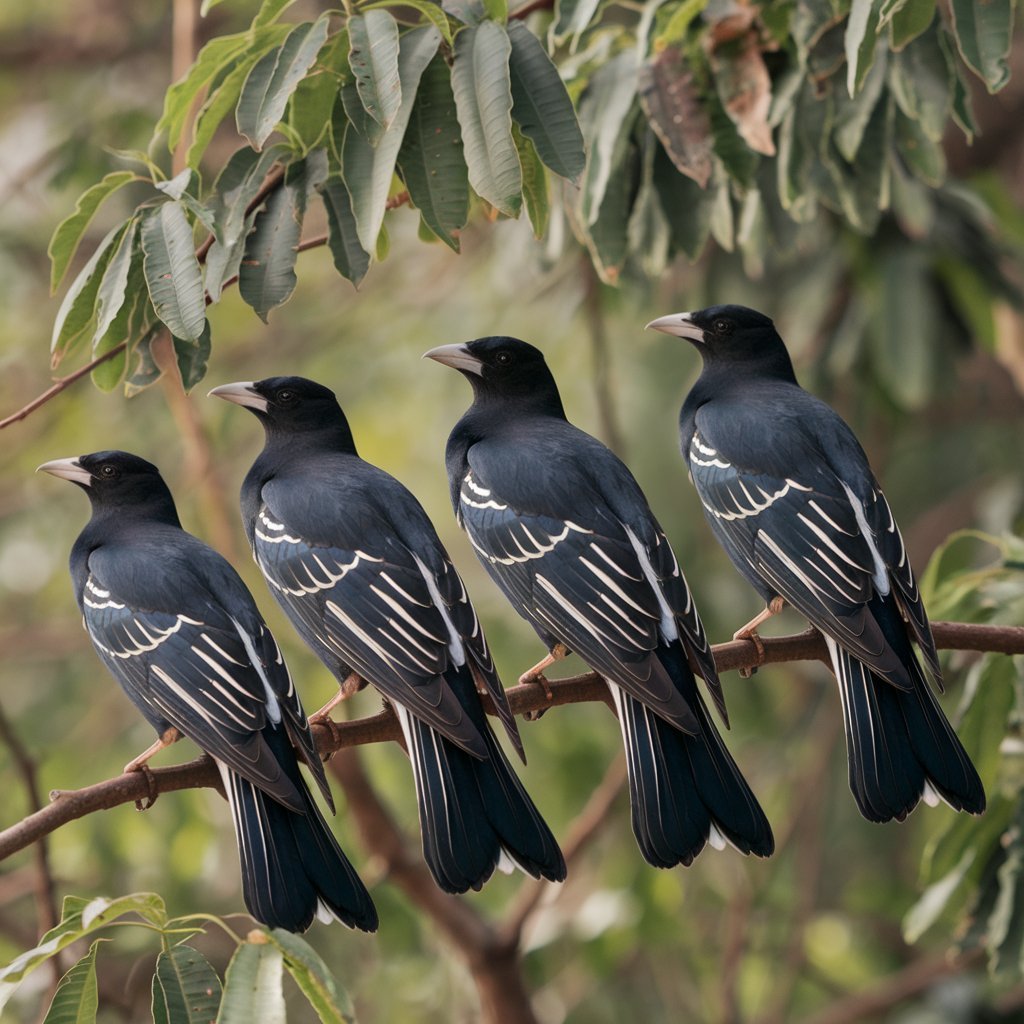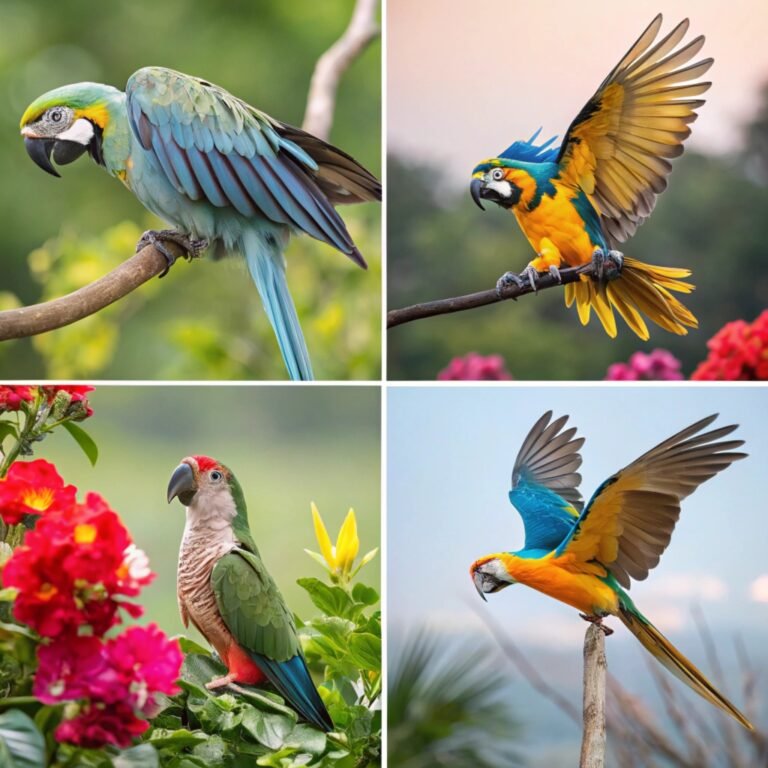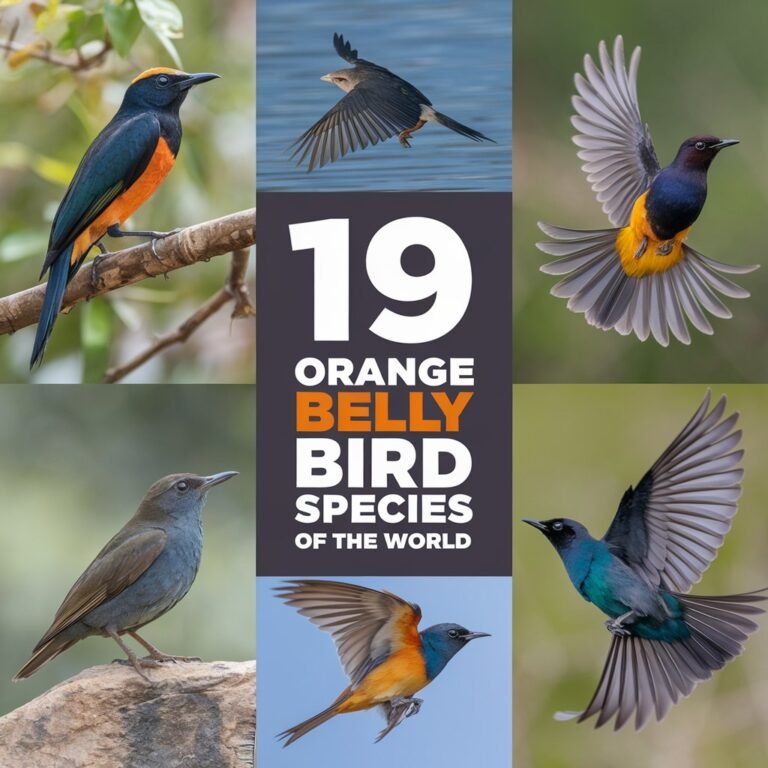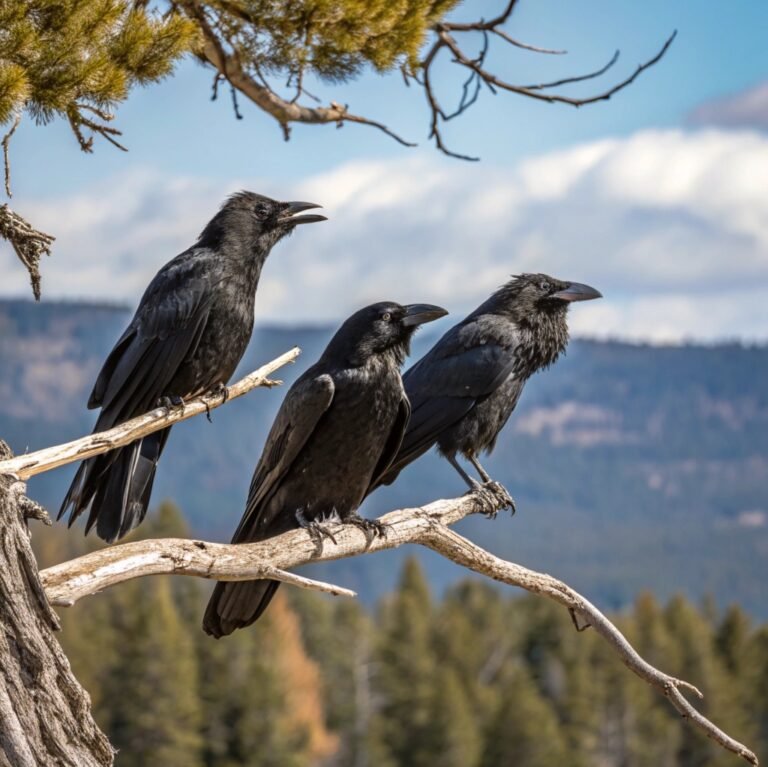11 Stunning Black Birds with White Stripe on Wing: A Comprehensive Guide
Black birds with white stripes on their wings are some of the most striking and easily recognizable avian species in the world. These birds captivate birdwatchers and nature enthusiasts alike with their bold contrasting plumage and unique characteristics.
In this comprehensive guide, we’ll explore 11 remarkable black birds with white wing stripes, delving into their identification features, habitats, and fascinating facts.
Whether you’re an experienced birder or a curious beginner, this post will equip you with the knowledge to spot and appreciate these beautiful creatures in their natural environments. From the Yellow-headed Blackbird to the Black-and-white Warbler, we’ll uncover the secrets of these avian wonders and their important roles in various ecosystems across the globe.

Key Takeaways
- Diverse Species: This guide covers 11 distinct black birds with white wing stripes, each with unique characteristics and habitats.
- Identification Tips: Learn to recognize these birds through their specific plumage patterns, size, and distinctive behaviors.
- Habitat Variety: Discover the wide range of environments these birds inhabit, from forests and grasslands to wetlands and urban areas.
- Ecological Importance: Understand the crucial roles these birds play in their ecosystems as pollinators, seed dispersers, and pest controllers.
- Conservation Status: Gain insights into the current population trends and conservation efforts for these species.
- Behavioral Traits: Explore the fascinating behaviors of these birds, including their mating rituals, feeding habits, and migration patterns.
- Adaptations: Learn about the unique adaptations that allow these birds to thrive in their specific environments.
- Cultural Significance: Discover the role of these birds in various cultures and folklore around the world.
- Birdwatching Tips: Get practical advice on how to spot and identify these birds in the wild.
- Photography Techniques: Learn tips and tricks for capturing stunning images of these black and white beauties.
1. Yellow-headed Blackbird: A Striking Contrast of Colors

The Yellow-headed Blackbird (Xanthocephalus xanthocephalus) is a stunning avian species that stands out with its bold black plumage and bright yellow head. This medium-sized bird, measuring about 9-10 inches in length, is easily identifiable by its distinctive coloration.
The male’s brilliant yellow head and breast contrast sharply with its black body, while females display a more subdued yellow-brown coloration. What makes this bird particularly interesting is the white patch on its wings, visible during flight.
These birds are primarily found in the western half of North America, inhabiting marshes, wetlands, and grasslands. Their diet consists mainly of insects and seeds, and they are known for their unique vocalizations that sound like a rusty gate opening. The Yellow-headed Blackbird plays a crucial role in its ecosystem by controlling insect populations and serving as prey for larger predators.
2. Black-and-white Warbler: The Zebra of the Forest

The Black-and-white Warbler (Mniotilta varia) is a small songbird that captivates with its striking zebra-like plumage. This unique warbler measures about 4.5 to 5 inches in length and is easily recognizable by its bold black and white stripes covering its entire body.
The bird’s wings feature distinctive white stripes that form a crescent shape when folded. Both males and females share this striking pattern, making identification relatively easy.
What sets the Black-and-white Warbler apart is its unusual foraging behavior – it creeps along tree trunks and branches, often upside down, much like a nuthatch.
This species is found in deciduous and mixed forests across North America, breeding in the northern regions and migrating to the southern United States, Central America, and the Caribbean for winter.
Their diet primarily consists of insects and spiders, which they glean from tree bark using their thin, slightly curved bill. The Black-and-white Warbler’s unique appearance and behavior make it a favorite among birdwatchers and nature enthusiasts.
3. Magpie-lark: Australia’s Black and White Beauty

The Magpie-lark (Grallina cyanoleuca), also known as the Peewee or Mudlark, is a distinctive black and white bird native to Australia. This medium-sized bird, measuring about 10 inches in length, is easily identifiable by its bold black and white plumage with prominent white eyebrows.
The Magpie-lark’s wings feature striking white stripes that contrast beautifully with its black body. Both males and females share similar coloration, but males have a black throat while females have a white one.
These birds are known for their unique mud nests and their habit of foraging on the ground in open areas. The Magpie-lark is found across most of Australia, inhabiting a wide range of environments from urban parks to rural farmlands.
They have a varied diet that includes insects, small reptiles, and seeds. One of the most fascinating aspects of the Magpie-lark is its duetting behavior, where mated pairs sing together in a coordinated display. This species plays an important role in Australian ecosystems and culture, often featuring in Aboriginal Dreamtime stories.
4. European Magpie: The Intelligent Black and White Corvid

The European Magpie (Pica pica) is a striking and intelligent member of the crow family, renowned for its distinctive black and white plumage. This large bird, measuring about 17-18 inches in length, is easily recognizable by its glossy black head, wings, and tail, contrasted with bright white shoulders and belly.
The magpie’s wings feature prominent white stripes that are particularly visible during flight. These birds are known for their high intelligence and have demonstrated self-awareness in mirror tests, a trait shared by only a few animal species.
European Magpies are found across Europe, parts of Asia, and northwest Africa, inhabiting a wide range of environments from urban areas to woodlands. They are omnivorous, feeding on insects, small mammals, eggs, and various plant materials.
Magpies are also known for their complex social behavior and their habit of collecting shiny objects. In many cultures, these birds have been associated with both good and bad omens, featuring prominently in folklore and superstitions. Despite their widespread presence, European Magpies face challenges from habitat loss and human persecution in some areas.
5. White-winged Widowbird: Africa’s Dramatic Black and White Weaver

The White-winged Widowbird (Euplectes albonotatus) is a striking bird species native to sub-Saharan Africa. This small to medium-sized bird, measuring about 5-6 inches in length, undergoes a dramatic transformation during the breeding season.
Male White-winged Widowbirds develop a jet-black plumage with bright white wing patches, creating a stunning contrast. The white wing stripes are particularly prominent during the bird’s elaborate courtship displays. Females and non-breeding males have a more subdued brown coloration.
These birds inhabit grasslands, savannas, and cultivated areas across their range. White-winged Widowbirds are known for their polygynous breeding system, where males establish and defend territories to attract multiple females.
Their diet primarily consists of seeds, supplemented with insects during the breeding season. One of the most fascinating aspects of this species is the male’s courtship display, which involves hovering with spread wings to show off the white patches.
Despite their widespread distribution, White-winged Widowbirds face threats from habitat loss due to agricultural expansion and overgrazing.
6. Black Phoebe: The Flycatcher with a White Wing Flash

The Black Phoebe (Sayornis nigricans) is a small flycatcher known for its distinctive black plumage and white belly. This bird, measuring about 6-7 inches in length, is easily identifiable by its dark charcoal-gray to black upper parts and crisp white underparts.
While the Black Phoebe doesn’t have prominent white wing stripes, it does display small white wing bars and a flash of white in its outer tail feathers during flight.
These birds are found in western North America and parts of South America, typically inhabiting areas near water sources such as streams, rivers, and ponds. Black Phoebes are known for their habit of repeatedly returning to the same perch after catching insects in mid-air.
They have adapted well to human presence and can often be seen in urban and suburban areas. Their diet consists primarily of flying insects, which they catch with remarkable agility.
Black Phoebes are also known for their distinctive call, a sharp “tsip” sound. These birds play an important role in controlling insect populations in their habitats and serve as indicators of environmental health.
7. Magpie-robin: Asia’s Melodious Black and White Songster

The Magpie-robin (Copsychus saularis), also known as the Oriental Magpie-robin, is a striking songbird native to South and Southeast Asia. This medium-sized bird, measuring about 7-8 inches in length, is easily recognizable by its glossy black upper parts and bright white underparts.
The Magpie-robin’s wings feature prominent white patches that are particularly visible during flight and courtship displays. Both males and females share similar coloration, but males tend to have more extensive white wing patches.
These birds are renowned for their beautiful and varied songs, often mimicking other bird species. Magpie-robins inhabit a wide range of environments, from urban gardens to forest edges. They are primarily insectivorous, feeding on a variety of insects and small invertebrates.
In many Asian cultures, the Magpie-robin is considered a symbol of good luck and is often kept as a caged bird for its melodious songs. However, this practice has led to population declines in some areas. Conservation efforts are underway to protect this beloved species and its habitats.
8. Black-backed Woodpecker: The Forest Fire Specialist
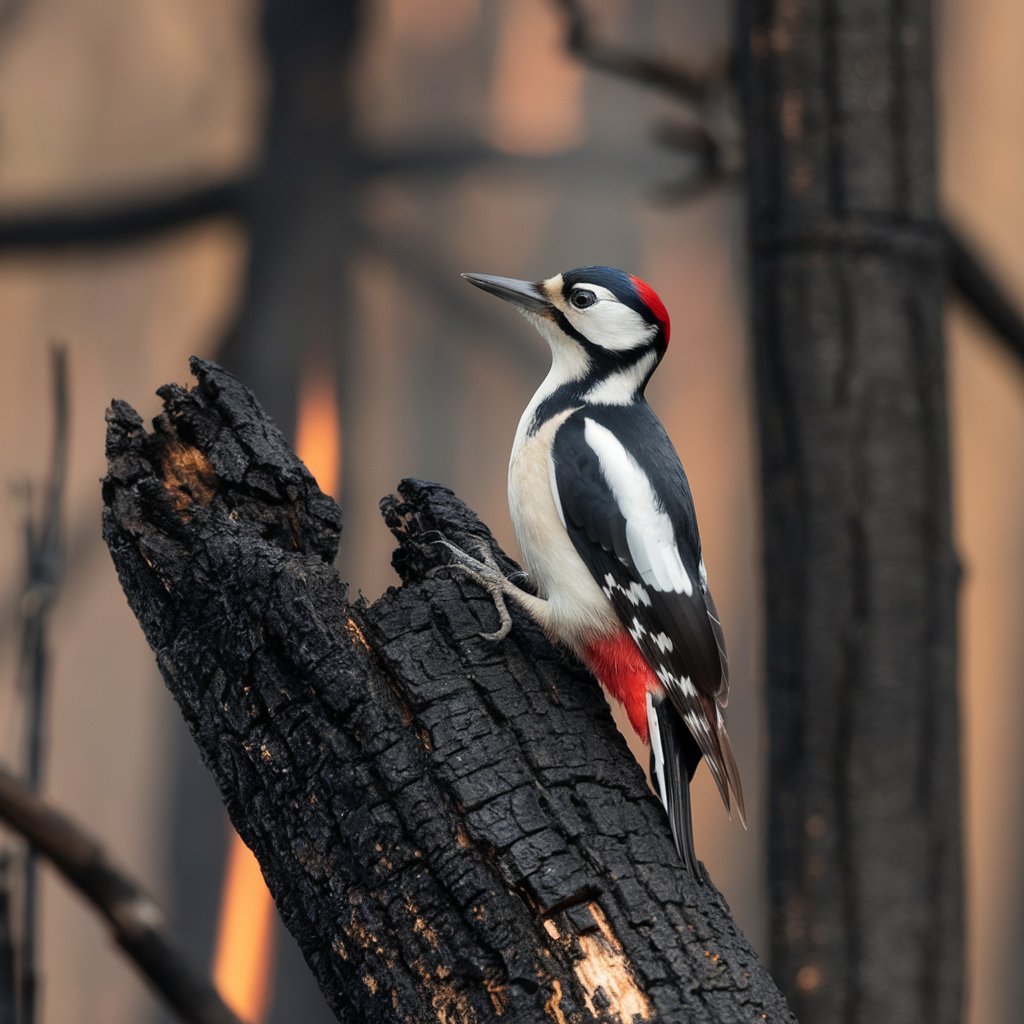
The Black-backed Woodpecker (Picoides arcticus) is a unique and specialized bird species known for its striking black and white plumage. This medium-sized woodpecker, measuring about 9-10 inches in length, is easily identifiable by its solid black back and white underparts.
While it doesn’t have prominent white wing stripes, it does display white bars on its wings and a distinctive white stripe on its face. What makes this woodpecker particularly interesting is its adaptation to burned forests.
Black-backed Woodpeckers are often found in recently burned coniferous forests across North America, where they feed on the wood-boring beetle larvae that infest fire-killed trees. Their strong bills and rigid tail feathers allow them to excavate deep into wood to find their prey.
These birds play a crucial role in post-fire forest ecosystems, helping to control insect populations and create nesting cavities for other species. Despite their specialized habitat preferences, Black-backed Woodpeckers face challenges from fire suppression practices and salvage logging in burned areas.
9. White-browed Wagtail: India’s Dapper Black and White Songbird

The White-browed Wagtail (Motacilla maderaspatensis), also known as the Large Pied Wagtail, is a striking black and white bird native to the Indian subcontinent.
This medium-sized bird, measuring about 8-9 inches in length, is easily recognizable by its bold black and white plumage with a distinctive white eyebrow.
The White-browed Wagtail’s wings feature prominent white stripes that contrast beautifully with its black body. Both males and females share similar coloration. These birds are known for their characteristic tail-wagging behavior, which gives them their common name.
White-browed Wagtails are found near water bodies across India, Sri Lanka, and parts of Southeast Asia, inhabiting a wide range of environments from urban areas to rural landscapes.
They feed primarily on insects and small invertebrates, often foraging on the ground or in shallow water. In Indian culture, the White-browed Wagtail is considered a symbol of good fortune and is often mentioned in folklore and literature. Despite their adaptability, these birds face challenges from habitat loss and water pollution in some areas.
10. Black-collared Starling: Asia’s Striking Black, White, and Yellow Beauty
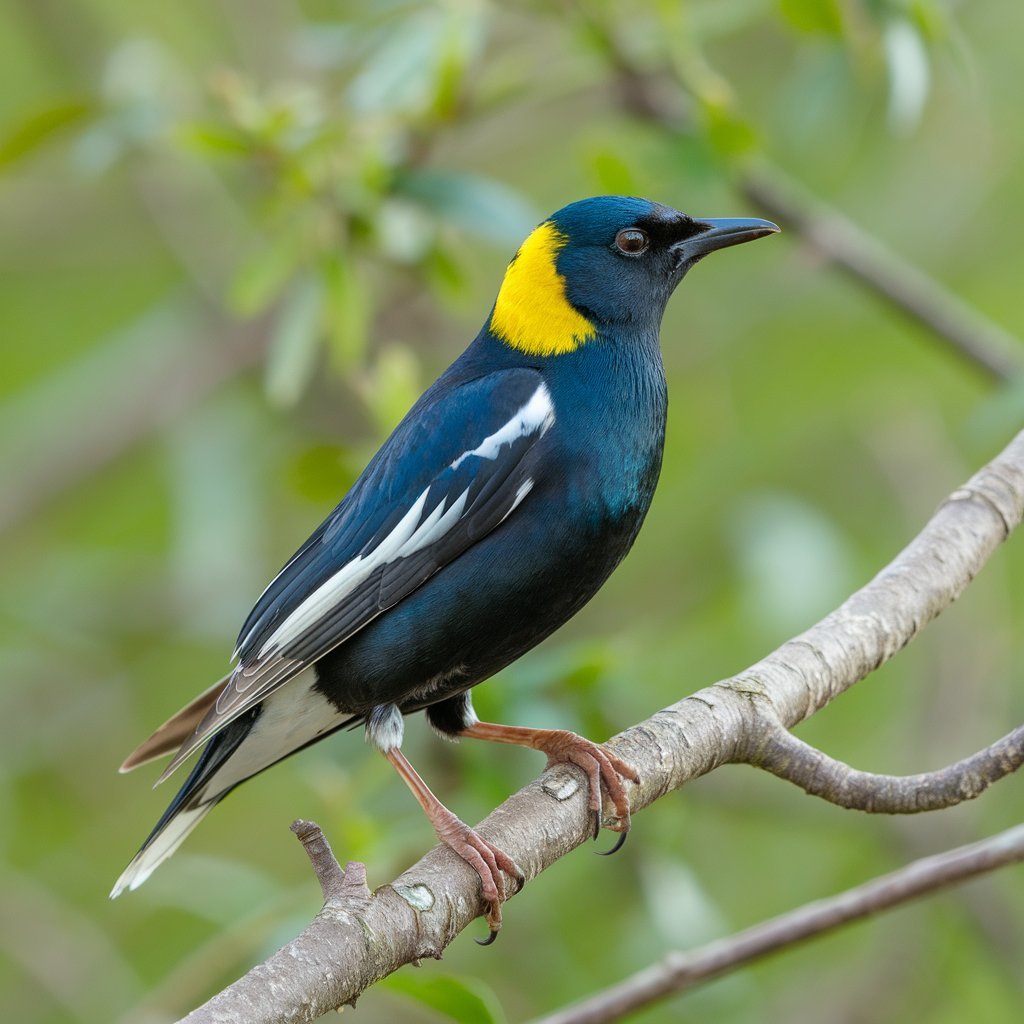
The Black-collared Starling (Gracupica nigricollis) is a visually stunning bird species native to Southeast Asia. This medium-sized starling, measuring about 9-10 inches in length, is easily identifiable by its unique combination of black, white, and yellow plumage.
The bird’s head and neck are bright yellow, contrasting sharply with a black collar and white body. Its wings feature prominent white stripes against a black background, creating a striking pattern. Both males and females share similar coloration.
Black-collared Starlings inhabit a variety of environments, including open woodlands, cultivated areas, and urban parks across countries like Vietnam, Thailand, and southern China. They are highly social birds, often seen in large flocks, and are known for their diverse vocalizations and ability to mimic sounds.
Their diet is omnivorous, consisting of fruits, insects, and small vertebrates. In some parts of their range, Black-collared Starlings are considered agricultural pests due to their fondness for crops. However, they also play important roles in seed dispersal and insect control.
Conservation efforts are focused on maintaining healthy populations of this charismatic species in the face of habitat loss and capture for the pet trade.
11. White-winged Triller: Australia’s Petite Black and White Songster

The White-winged Triller (Lalage tricolor) is a small but striking bird species native to Australia. This petite songbird, measuring about 6-7 inches in length, is known for its seasonal plumage changes.
During the breeding season, male White-winged Trillers develop a bold black and white plumage, with a black head, back, and tail contrasting with a white belly and prominent white wing patches. Females and non-breeding males have a more subdued gray-brown coloration.
The white wing stripes are particularly visible during the bird’s courtship displays and in flight. White-winged Trillers inhabit a wide range of environments across Australia, from open woodlands to scrublands and urban parks.
They are known for their melodious songs and are often heard before they are seen. These birds are primarily insectivorous, feeding on a variety of insects caught in mid-air or gleaned from vegetation.
White-winged Trillers play an important role in controlling insect populations in their habitats. While they are currently not considered threatened, these birds face challenges from habitat loss due to land clearing and urbanization in some areas.
FAQs
What is the most common black bird with white stripes on its wings?
The most common black bird with white stripes on its wings varies by region, but in North America, the Yellow-headed Blackbird is quite prevalent in its range. In Europe and parts of Asia, the European Magpie is a common sight.
How can I identify a black bird with white wing stripes in flight?
Look for the contrast between the black body and white wing patches during flight. The pattern and extent of white on the wings can help identify specific species. For example, the White-winged Triller has extensive white patches, while the Black-and-white Warbler has thinner white stripes.
Are all black birds with white wing stripes related?
No, not all black birds with white wing stripes are closely related. This color pattern has evolved independently in various bird families, including warblers, starlings, blackbirds, and woodpeckers.
Do female black birds with white wing stripes look different from males?
In some species, like the White-winged Widowbird, males and females look quite different, with males

Hello, I’m Emily Price, the founder of Birds Affection. As a passionate bird enthusiast and spiritual seeker, I’ve always been fascinated by the symbolic meanings and mystical connections between birds and our lives. On this website, I share my knowledge and insights on the spiritual significance of various bird species, exploring their roles as messengers, guides, and teachers. Through my writing, I aim to inspire and educate others on the profound wisdom and beauty that birds bring to our world. Join me on this journey as we delve into the enchanting realm of bird symbolism and discover the hidden meanings behind these magnificent creatures.

